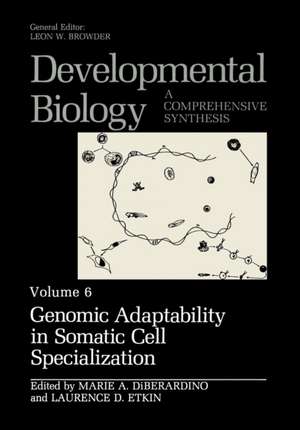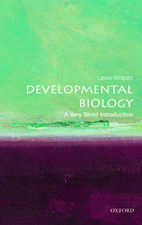Genomic Adaptability in Somatic Cell Specialization: Developmental Biology, cartea 6
Editat de Marie A. DiBerardino, Laurence D. Etkinen Limba Engleză Paperback – 13 apr 2012
Preț: 389.88 lei
Nou
Puncte Express: 585
Preț estimativ în valută:
74.61€ • 77.61$ • 61.60£
74.61€ • 77.61$ • 61.60£
Carte tipărită la comandă
Livrare economică 14-28 aprilie
Preluare comenzi: 021 569.72.76
Specificații
ISBN-13: 9781461568223
ISBN-10: 1461568226
Pagini: 260
Ilustrații: XIII, 242 p.
Dimensiuni: 178 x 254 x 14 mm
Greutate: 0.46 kg
Ediția:Softcover reprint of the original 1st ed. 1989
Editura: Springer Us
Colecția Springer
Seria Developmental Biology
Locul publicării:New York, NY, United States
ISBN-10: 1461568226
Pagini: 260
Ilustrații: XIII, 242 p.
Dimensiuni: 178 x 254 x 14 mm
Greutate: 0.46 kg
Ediția:Softcover reprint of the original 1st ed. 1989
Editura: Springer Us
Colecția Springer
Seria Developmental Biology
Locul publicării:New York, NY, United States
Public țintă
ResearchCuprins
1 · Introduction: Early Development and Cell Commitment.- 1. Introduction.- 2. The Genome during Development.- 3. Regulation of Early Development and Cell Specialization.- 4. Specification and Stability of Cell Lineages in Early Embryogenesis.- 5. Changes or Modulations of Cell Phenotype in Determined and Differentiated Cells.- 6. Molecular Mechanisms of Gene Regulation and Heritability of the Determined or Differentiated State.- References.- 2 · DNA Gains, Losses, and Rearrangements in Eukaryotes.- 1. Introduction.- 2. Gain of DNA Sequences.- 3. Rearrangement of DNA Sequences.- 4. Loss of DNA Sequences.- 5. The Ciliate Genome.- 6. Conclusions.- References.- 3 · Fate and Nuclear Localization of Germinal Vesicle Proteins during Embryogenesis.- 1. Oogenesis.- 2. Oocyte Maturation.- 3. Fate of Oocyte Nuclear Proteins after Fertilization.- 4. Nuclear Differentiation during Organogenesis.- 5. Summary and Prospects.- References.- 4 · Genomic Imprinting in the Mouse.- 1. Introduction.- 2. Nuclear Totipotency.- 3. Development of Eggs with Only Maternal Genomes.- 4. Development of Eggs with Only Paternal Genomes.- 5. Is the Parental Origin of Early Embryonic Nuclei Remembered?.- 6. Embryo Reconstruction.- 7. Chromosomal Imprinting.- 8. Probing Imprinted Domains.- 9. Conclusions.- References.- 5 · Phenotypic Changes in Cell Culture.- 1. Introduction.- 2. Modulative Shifts in Phenotype.- 3. Stable Changes in Gene Expression.- 4. Concluding Remarks.- References.- 6 · Developmental Regulation of the Heat-Shock Response.- 1. Introduction.- 2. The Heat-Shock Response.- 3. Developmental Regulation.- 4. Conclusions.- References.- 7 · Transdifferentiation in Animals: A Model for Differentiation Control.- 1. Introduction.- 2. Primary Transdifferentiation.- 3. SecondaryTransdifferentiation.- 4. Tertiary Transdifferentiation.- 5. Possible Mechanisms in Transdifferentiation.- References.- 8 · Genomic Activation in Differentiated Somatic Cells.- 1. Introduction.- 2. Nuclear Transfers from Differentiated Somatic Tissues.- 3. Nuclear Transfers from Germ Cells.- 4. Imprinting of the Genome.- 5. Reversal of Genomic Imprinting.- 6. Mechanisms of Genomic Activation.- 7. Conclusions and Perspectives.- References.- 9 · Neoplastic Cells: Modulation of the Differentiated State.- 1. Introduction: The Concept of Cancer Cell Differentiation.- 2. Cancer and Stem Cells.- 3. Neoplasms That Differentiate.- 4. Cancer Cell Differentiation: A Brief Chronicle.- 5. Control of Differentiation of Embryo Cells and Cancer Cells: Are There Commonalities?.- References.















